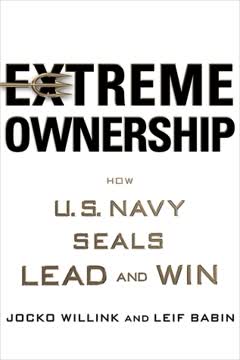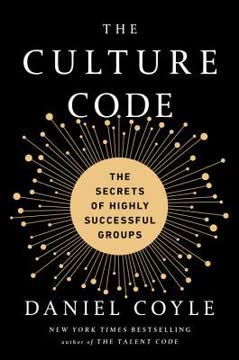Key Takeaways
1. Build safety through belonging cues to create strong group culture
Belonging cues possess three basic qualities: Energy: They invest in the exchange that is occurring, Individualization: They treat the person as unique and valued, Future orientation: They signal the relationship will continue.
Belonging drives performance. Groups that create psychological safety through consistent belonging cues outperform those that don't. These cues include eye contact, physical proximity, mimicry, turn-taking in conversation, attentive listening, and small courtesies. They send a powerful message: "You are safe here. We share a future."
Key ways to build belonging:
- Ensure everyone has a voice
- Communicate expectations clearly
- Deliver negative feedback in person
- Express gratitude frequently
- Create collision-rich spaces for interaction
2. Vulnerability loops foster trust and cooperation within teams
Exchanges of vulnerability, which we naturally tend to avoid, are the pathway through which trusting cooperation is built.
Vulnerability builds connection. When team members share weaknesses and ask for help, it creates a "vulnerability loop" that fosters trust and cooperation. This is why activities that create shared struggle, like military training exercises, build such strong bonds.
Elements of effective vulnerability loops:
- Leader goes first in showing vulnerability
- Focus on two key moments: first vulnerability and first disagreement
- Frame feedback as learning opportunities, not judgments
- Create safe spaces for open discussion and disagreement
3. Shared purpose aligns group behavior and drives performance
We believe our first responsibility is to doctors, nurses, and patients; to mothers and fathers and all others who use our products and services.
Purpose guides decisions. A clear shared purpose, like Johnson & Johnson's Credo, aligns behavior across an organization. It provides a north star for navigating difficult choices. Purpose is built through consistent signals that connect present actions to future ideals.
Ways to build shared purpose:
- Name and rank priorities explicitly
- Overcommunicate purpose and values
- Create rituals that reinforce core ideals
- Link daily work to larger mission
- Test and refine purpose regularly
4. Leaders shape culture by modeling vulnerability and fostering openness
Cooper realizes that (1) the teams are in a better position to solve problems, and (2) a suggestion from a powerful person tends to be followed.
Leaders set the tone. Effective leaders model vulnerability, ask for help, admit mistakes, and create psychological safety. They focus on empowering their teams rather than directing every decision. This approach unlocks creativity and builds ownership.
Leadership techniques for fostering openness:
- Ask questions instead of giving orders
- Encourage dissent and alternative viewpoints
- Celebrate failures as learning opportunities
- Give teams autonomy to solve problems
- Provide support without micromanaging
5. High-purpose environments link present actions to future ideals
High-purpose environments are filled with small, vivid signals designed to create a link between the present moment and a future ideal.
Purpose motivates action. Successful cultures create high-purpose environments that constantly reinforce the link between present efforts and future goals. This provides meaning and motivation, especially during difficult times.
Elements of high-purpose environments:
- Visual reminders of mission and values
- Stories that illustrate impact
- Clear performance targets linked to larger purpose
- Regular reflection on progress toward goals
- Celebration of milestones and achievements
6. Successful cultures balance proficiency and creativity
The interesting thing about all those phrases is the way Danny embodies them. What he's exceptional at is realizing that people are looking at him every second, and he's delivering those messages every second, every day.
Different skills require different approaches. Proficiency skills benefit from clear rules and repetition, while creative skills require autonomy and support. Successful cultures tailor their approach based on the type of performance they seek to cultivate.
Strategies for building proficiency:
- Create clear, memorable heuristics
- Provide high-repetition training
- Spotlight role models of excellence
Strategies for fostering creativity:
- Protect creative autonomy
- Encourage experimentation and risk-taking
- Focus on team dynamics and composition
7. Crisis moments can crystallize group purpose and identity
The difference with successful cultures seems to be that they use the crisis to crystallize their purpose.
Adversity builds identity. Many strong cultures trace their core identity to moments of crisis that forced them to clarify their purpose and values. These moments become part of the group's shared narrative and guide future behavior.
Ways to leverage crisis:
- Frame challenges as opportunities for growth
- Reinforce core values during difficult times
- Capture lessons learned from overcoming adversity
- Celebrate resilience and adaptability
- Use crisis to spur necessary changes
8. Simple heuristics guide complex group behaviors
We assume that because we're complex, that the way we make decisions is also complex. But in reality, we're using very simple rules of thumb.
Simple rules enable complex behavior. Just as simple rules guide the complex behavior of slime molds or ant colonies, successful human groups often rely on a small set of guiding principles or heuristics. These provide clarity and alignment without being overly restrictive.
Characteristics of effective heuristics:
- Simple and memorable
- Applicable to a wide range of situations
- Aligned with group values and purpose
- Regularly reinforced through stories and practice
- Evolve based on experience and feedback
9. Physical proximity and interaction fuel group cohesion
What matters most in creating a successful team had less to do with intelligence and experience and more to do with where the desks happened to be located.
Proximity breeds connection. Physical closeness and frequent interaction are crucial for building group cohesion and creativity. This is why successful organizations design spaces to maximize "collisions" between team members.
Ways to leverage proximity:
- Create shared spaces for informal interaction
- Align schedules to increase overlap time
- Use technology to bridge physical distance
- Encourage cross-functional projects and teams
- Host regular social events and team-building activities
10. Continuous feedback and improvement drive innovation
All the movies are bad at first. Some are beyond bad. Frozen and Big Hero 6, for instance, were unmitigated disasters. The stories were flat, the characters weren't there. They sucked.
Embrace the messy middle. Innovation requires a willingness to start with imperfect ideas and continuously refine them through feedback and iteration. Successful creative cultures build in regular opportunities for candid critique and improvement.
Key elements of effective feedback systems:
- Create psychological safety for honest critique
- Separate idea generation from evaluation
- Focus on specific, actionable feedback
- Encourage rapid prototyping and experimentation
- Celebrate learning and improvement, not just outcomes
Last updated:
FAQ
What's "The Culture Code" about?
- Group Success: "The Culture Code" by Daniel Coyle explores the secrets behind highly successful groups, examining how they create cultures that foster collaboration and achievement.
- Three Skills: The book identifies three key skills that drive successful group cultures: building safety, sharing vulnerability, and establishing purpose.
- Real-World Examples: Coyle provides insights from various successful groups, including special-ops military units, sports teams, and innovative companies, to illustrate how these skills are applied in practice.
- Practical Guidance: The book offers practical advice and strategies for leaders and members of any group to enhance their culture and improve performance.
Why should I read "The Culture Code"?
- Improve Team Dynamics: The book provides valuable insights into improving team dynamics and fostering a culture of trust and cooperation.
- Actionable Strategies: It offers actionable strategies that can be applied to any group setting, from corporate teams to sports teams and beyond.
- Real-Life Success Stories: Coyle uses real-life success stories to illustrate the principles, making the concepts relatable and easy to understand.
- Enhance Leadership Skills: Readers can enhance their leadership skills by learning how to create environments that encourage innovation and collaboration.
What are the key takeaways of "The Culture Code"?
- Safety is Crucial: Building a sense of safety within a group is essential for fostering trust and open communication.
- Vulnerability Leads to Trust: Sharing vulnerability is a powerful way to build trust and cooperation among group members.
- Purpose Drives Performance: Establishing a clear and compelling purpose helps align group efforts and motivates members to achieve common goals.
- Continuous Learning: Successful groups are constantly learning and adapting, using feedback and reflection to improve.
How does Daniel Coyle define "building safety" in "The Culture Code"?
- Connection Signals: Building safety involves sending clear signals of connection and belonging to create a secure environment.
- Nonverbal Cues: Nonverbal cues such as eye contact, body language, and tone of voice play a significant role in establishing safety.
- Open Communication: Encouraging open communication and active listening helps reinforce a sense of safety within the group.
- Inclusive Environment: Creating an inclusive environment where everyone feels valued and heard is key to building safety.
What is the "vulnerability loop" concept in "The Culture Code"?
- Exchange of Vulnerability: The vulnerability loop is a shared exchange of openness that builds trust and cooperation within a group.
- Five Steps: It involves five steps: one person signals vulnerability, the other detects it, responds with their own vulnerability, the first person detects this, and trust is established.
- Contagious Effect: Vulnerability loops are contagious, spreading trust and cooperation throughout the group.
- Foundation of Trust: These loops are foundational for creating a culture where members feel safe to take risks and collaborate.
How does "The Culture Code" suggest establishing purpose in a group?
- Clear Goals: Establishing purpose involves setting clear, compelling goals that align with the group's values and mission.
- Consistent Messaging: Purpose is reinforced through consistent messaging and storytelling that connects daily activities to the larger mission.
- Role Clarity: Ensuring that each member understands their role and how it contributes to the group's purpose is crucial.
- Engagement and Motivation: A strong sense of purpose engages and motivates group members, driving them to achieve shared objectives.
What are some real-world examples used in "The Culture Code"?
- Navy SEALs: The book examines how Navy SEALs build trust and cooperation through rigorous training and shared vulnerability.
- Pixar: Coyle explores how Pixar fosters creativity and collaboration through open feedback and a strong sense of purpose.
- Google: The book highlights Google's culture of innovation and safety, which encourages employees to take risks and share ideas.
- Zappos: Zappos is used as an example of a company that prioritizes employee happiness and customer service to create a strong culture.
What are the best quotes from "The Culture Code" and what do they mean?
- "Safety is not mere emotional weather but rather the foundation on which strong culture is built." This quote emphasizes the importance of creating a safe environment as the basis for a successful group culture.
- "Vulnerability doesn’t come after trust—it precedes it." This highlights the idea that sharing vulnerability is a prerequisite for building trust within a group.
- "Culture is a set of living relationships working toward a shared goal." This quote defines culture as dynamic and relational, focused on achieving common objectives.
- "The goal needs to be to get the team right, get them moving in the right direction, and get them to see where they are making mistakes and where they are succeeding." This underscores the importance of team dynamics and continuous improvement.
How does "The Culture Code" address the role of leadership in successful groups?
- Modeling Behavior: Leaders play a crucial role by modeling the behaviors they want to see in their group, such as openness and vulnerability.
- Creating Safe Environments: Effective leaders create environments where members feel safe to express ideas and take risks.
- Facilitating Purpose: Leaders help establish and communicate the group's purpose, aligning efforts toward common goals.
- Encouraging Feedback: Successful leaders encourage feedback and reflection, fostering a culture of continuous learning and improvement.
What practical strategies does "The Culture Code" offer for improving group culture?
- Overcommunicate Listening: Actively listen and engage with group members to reinforce a sense of safety and connection.
- Embrace Vulnerability: Encourage sharing of vulnerabilities to build trust and cooperation within the group.
- Use Catchphrases: Develop and use catchphrases to reinforce the group's purpose and values consistently.
- Conduct After-Action Reviews: Implement regular reviews to reflect on performance, learn from mistakes, and improve.
How does "The Culture Code" differentiate between proficiency and creativity in group settings?
- Proficiency Focus: Proficiency involves delivering consistent, reliable performance and is supported by clear goals and rules.
- Creativity Focus: Creativity requires exploration and innovation, supported by autonomy and a safe environment for experimentation.
- Different Approaches: Building purpose for proficiency involves clear direction and repetition, while creativity requires support and flexibility.
- Balancing Both: Successful groups often balance proficiency and creativity, tailoring their approach to the specific needs of each area.
What is the significance of "high-purpose environments" in "The Culture Code"?
- Purposeful Signals: High-purpose environments are filled with signals that connect present actions to future goals, guiding group behavior.
- Consistent Messaging: These environments use consistent messaging to reinforce the group's mission and values.
- Engagement and Motivation: A strong sense of purpose engages and motivates group members, driving them to achieve shared objectives.
- Cultural Cohesion: High-purpose environments foster cultural cohesion, aligning individual efforts with the group's overarching goals.
Review Summary
The Culture Code receives mostly positive reviews for its engaging stories and insights on building effective team cultures. Readers appreciate the practical tips on fostering psychological safety, vulnerability, and shared purpose. Some criticize the book for lacking diversity in examples and relying heavily on anecdotes. Many find it useful for leaders and team members, though some consider it basic or oversimplified. The book's emphasis on creating environments of trust and belonging resonates with many readers, who find it applicable to various organizational settings.
Similar Books










Download PDF
Download EPUB
.epub digital book format is ideal for reading ebooks on phones, tablets, and e-readers.







